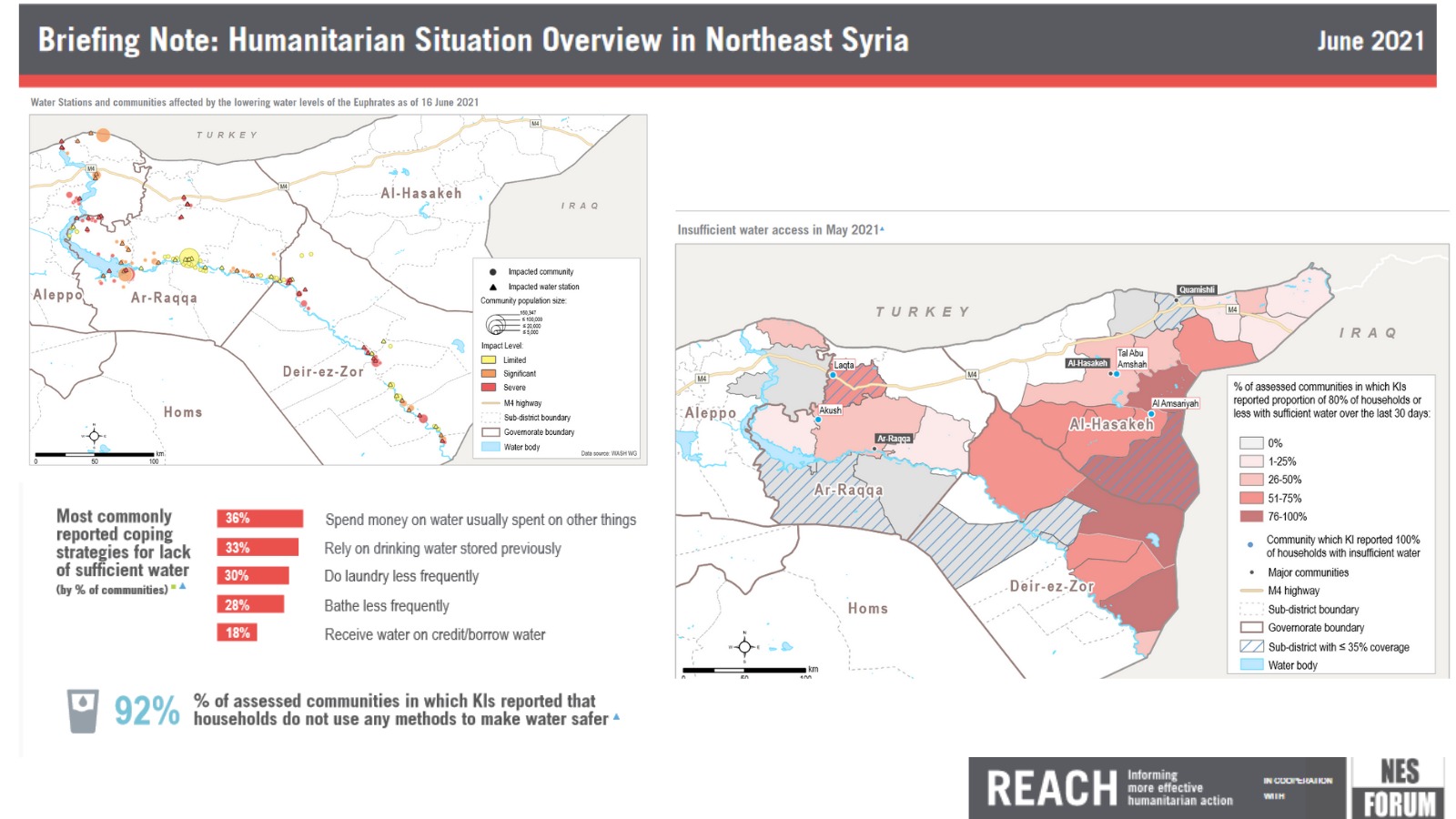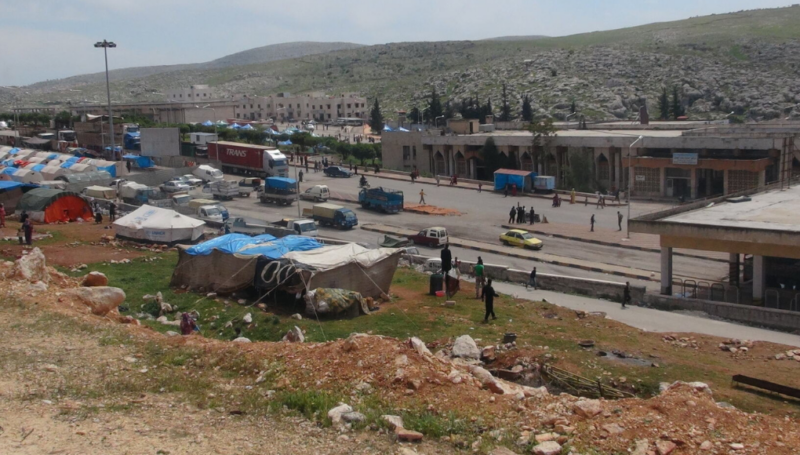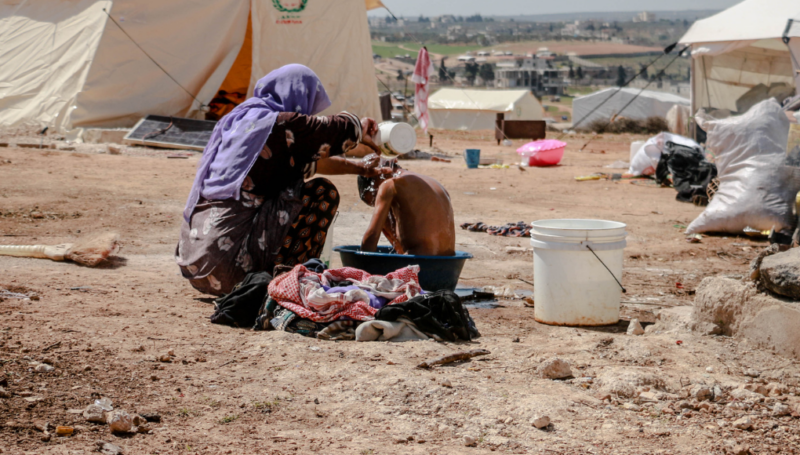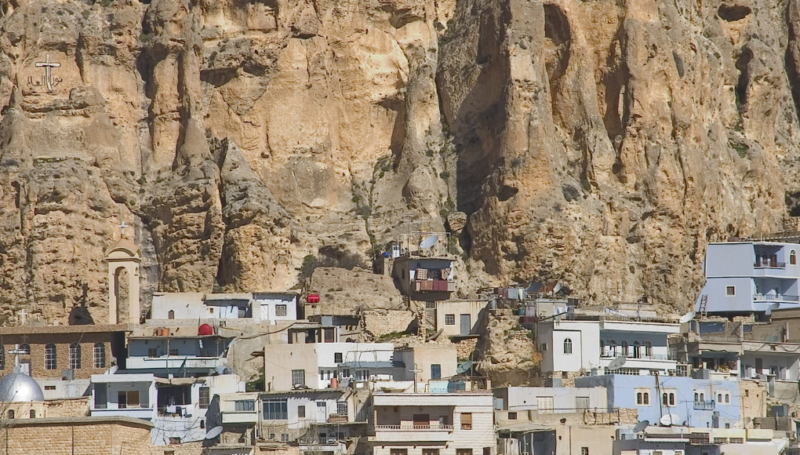Reduced water levels in the Euphrates River has wide-ranging humanitarian impacts for millions of people in Syria, including their access to water and electricity. IMPACT/REACH has produced a thorough Situation Overview on both the context and the impact of this looming disaster.
Korbinian Schink, IMPACT/REACH Country Coordinator for Syria, explains, “When millions of people stand to lose access to water – water for drinking, water for hygiene, water for agriculture, and water for life – the result is human suffering. The present factsheet, a zoom-in on the multi-layered crisis by the IMPACT/REACH Humanitarian Situation Monitoring team, seeks to shine a light on the complexity of this crisis, focusing on the intersectoral linkages needed for an effective humanitarian response.”
Indeed in recent months, as a result of a critically low water flow rate in the Euphrates River, important dams in the area have shrunk to historic lows, including Tishreen in north-eastern Aleppo and Tabqa in Ar-Raqqa Governorate. That, in turn, has had serious ramifications impacting the well-being of civilians in the region, including limited access to clean drinking water and widespread power blackouts.
In April 2021, the Global Drought Observatory (GDO) issued a drought warning for eastern Syria, notably the country’s breadbasket. Their drought analysis for Northeast Syria (NES) placed vast territories under High to Moderate risk, regions that, according to the Food and Agriculture Organization of the United Nations (FAO), are already “dry” and “cold” with “low production potential” and “erratic rainfall.”
While the GDO’s warning from April becomes ever more salient as time passes, the contributing factors necessary to appreciate the “risk” go well beyond what the Syrian Ministry of Agriculture has called the country’s worst drought in seventy years. Keeping with drought alone, the conflict in Syria that started over a decade ago subsists amid a much broader, much more extended period of regional drought considered the worst of its kind in at least the past nine centuries
As stated by the UN, “current estimates indicate over five million people, including in north-east Syria, are reliant on the Euphrates for their drinking water, and approximately three million people for electricity. Vital infrastructure, including hospitals, irrigation networks, and water stations, are also reportedly affected. Should the situation not improve, possible longer-term impacts include damage to agriculture; a worsening of already dire food insecurity; loss of livelihoods; and a severe undermining of overall public health.”
The key findings from the IMPACT/REACH Situation overview confirm this statement:
- Households in 15% of the assessed communities are already limiting their drinking water consumption due to lack of access to sufficient water. Indeed lack of electricity and low water levels are causing limited operation of a number of water pumping stations, increasing dependence on alternatives for household water usage across NES. Alternative water sources in communities connected to affected water pumping stations were water trucking (93%), followed by surface water (16%). However, the reported price of water trucking has increased dramatically in Ar-Raqqa sub-district in the six months prior to data collection, preventing households from accessing sufficient water, as it is reported as a barrier in 64% of assessed communities.
- Households are increasingly relying on alternative sources of drinking water that could expose them to waterborne diseases, including water transported or stored in unclean tanks exposed to high temperatures for extended periods. Indeed if surface water usage increases, households will be at increased risk of illness, as there are no habitual water sanitisation methods reportedly used by families in Northeast Syria. According to REACH’s data collected in June, water-related illnesses were reported in 35% of the assessed communities.
- Drought conditions destroyed large swaths of rainfed crops resulting in a devastating loss of income for farmers. Moreover, failed barley crops are expected to affect the availability of animal feed in the coming season, with high rates of livestock death already reported in 14% of assessed communities in May. A continued decline in access to river water and electricity due to lowering levels of the Euphrates and a rise in fuel prices (30% increase since the start of the year) and aggravating factors such as damaged irrigation infrastructure are likely to affect the quality of irrigated crops. A lack of sufficient irrigation water quantities in the public irrigation canals, dams, and lakes was reported by Key Informants as a challenge for farmers in 39% of communities assessed by REACH in June 2021.
- While crop loss is expected to impact food availability, the biggest challenge for households is the unaffordability of food items. According to HNAP income data from January 2021, a family with a median income of 250,000 SYP would have to spend 84% of that just on the May Survival Minimum Expenditure Basket (SMEB) food component alone. In 21% of communities assessed by REACH, Key Informants reported that approximately 25% of households in the community rely on one meal or less per day.
Korbinian Schink, the IMPACT/REACH Country Coordinator for Syria, concludes, “Vulnerable population living in the area are experiencing the local consequences of the global climate crisis, which is affecting not only Syria but the broader region. There is a need to set up climate monitoring at a regional scale, using all tools at our disposal – including remote sensing.”
The situation overview is accessible attached and on the REACH Resource Centre.










